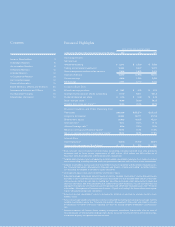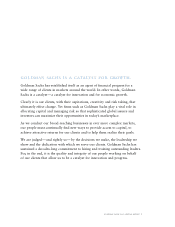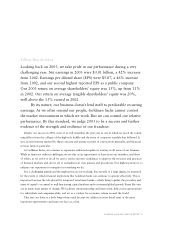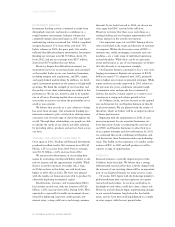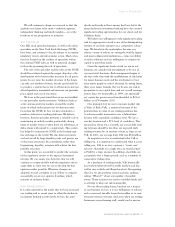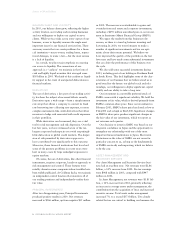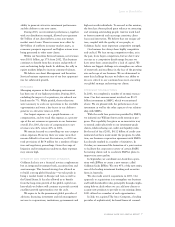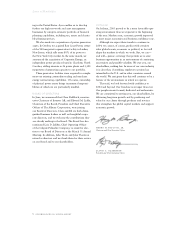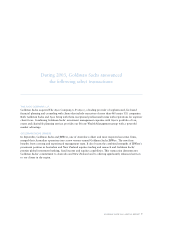Goldman Sachs 2003 Annual Report Download - page 8
Download and view the complete annual report
Please find page 8 of the 2003 Goldman Sachs annual report below. You can navigate through the pages in the report by either clicking on the pages listed below, or by using the keyword search tool below to find specific information within the annual report.
6GOLDMAN SACHS 2003 ANNUAL REPORT
Letter to Shareholders
BALANCE SHEET AND LIQUIDITY
In 2003, our balance sheet grew, reflecting the higher
activity levels in our trading and investing businesses
and our willingness to deploy our capital to serve
clients. While we face risks across every aspect of our
business, access to liquidity remains the single most
important issue for any financial services firm. There
are many events that can create problems for a finan-
cial institution—macro events, trading losses, reputa-
tional damages, to name a few—but the most serious
is a lack of liquidity.
As a result, we place major emphasis on assuring
our access to liquidity. The cornerstone of our
approach is a “cushion” we maintain in the form of
cash and highly liquid securities that averaged some
$38 billion in 2003. We think of this cushion as liquid-
ity support in the event of unexpected dislocations in
financial markets.
DERIVATIVES
The use of derivatives, a key part of our trading activi-
ty, has been the subject of increased debate recently.
Derivatives span a wide range—from a simple interest
rate swap that allows a company to convert its fixed
rate borrowing into a floating rate exposure, to more
complex instruments like credit derivatives that allow
investors to hedge risk associated with credit exposures
in their portfolios.
While derivatives can be misused, they are a vital
tool for risk management and risk dispersion. Over the
last few years, we have witnessed seven of the ten
largest corporate bankruptcies ever with surprisingly
little dislocation in global credit markets. The disper-
sion of risk permitted by derivatives appears to
have contributed very significantly to this outcome.
Moreover, those financial institutions that have had
some of the greatest problems in recent years were
hurt in many cases by large unhedged exposures to
equity markets.
Of course, the use of derivatives, like other financial
instruments, requires a rigorous, hands-on approach to
risk management and control. These features were
notably absent in some companies whose troubles have
been widely publicized. At Goldman Sachs, we maintain
an independent control function that monitors all of
our trading positions and independently verifies their
fair value.
PRINCIPAL INVESTMENTS
After two disappointing years, Principal Investments
produced positive results in 2003. Net revenues
increased to $566 million, up from negative $35 million
in 2002. The increase was attributable to gains and
overrides from real estate and corporate investments,
including a $293 million unrealized gain on our invest-
ment in Sumitomo Mitsui Financial Group (SMFG).
We expect the results from this business to be
uneven, as there is a time lag between investing and
harvesting. In 2003, we were fortunate to make a
number of significant investments and we are opti-
mistic about their return potential. We believe we
have improved the quality of the portfolio in the last
few years and have made some substantial investments
that can drive the performance of this business over
the cycle.
We also sold some successful investments during
2003, including part of our holding in Kookmin Bank
in South Korea. This deal highlights some of the char-
acteristics of our business that we believe stand us in
good stead for the future: our global reach and rela-
tionships, our willingness to deploy significant capital
swiftly and our ability to take a long view.
Our investment in convertible preferred stock of
SMFG carries with it significant volatility. We hold the
investment at fair value, which is derived primarily from
SMFG’s common share price. Since our investment in
February 2003, SMFG’s share price has closed as low as
¥164,000 and as high as ¥665,000. Significant changes
in SMFG’s share price produce significant changes in
the fair value of our investment, which we report as
net revenues each quarter.
Our decision to invest in SMFG was based on our
long-term confidence in Japan and the opportunity to
strengthen our relationship with one of the most
important financial institutions in Japan. Short-term
fluctuations in the value of SMFG are not cause for
particular concern to us, as long as the fundamentals
of SMFG are steady and improving, which we believe
to be the case.
ASSET MANAGEMENT AND
SECURITIES SERVICES
Our Asset Management and Securities Services busi-
ness had an excellent year. Net revenues were $2.86
billion, a 14% increase from 2002. Pre-tax earnings
were $968 million in 2003, compared with $947
million in 2002.
In Asset Management, net revenues were $1.85 bil-
lion, a 12% increase from 2002, primarily reflecting
an increase in average assets under management, the
contribution from the acquisition of Ayco and increased
incentive income. Total assets under management
increased 7% to a record $373 billion. Two closely
related factors are critical to building our business: the


